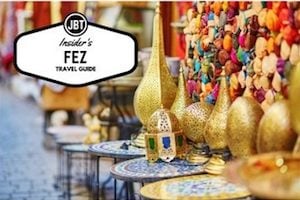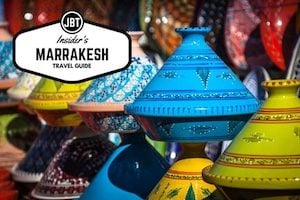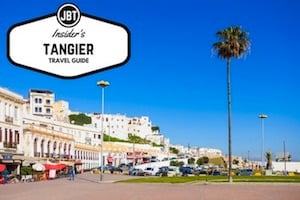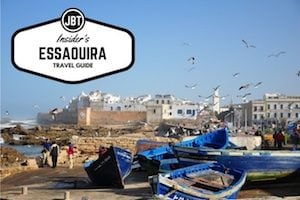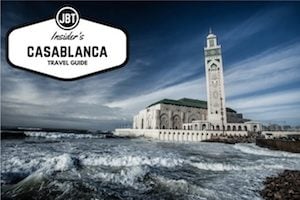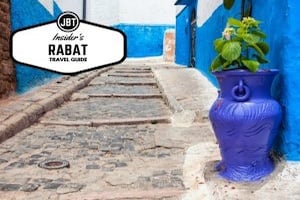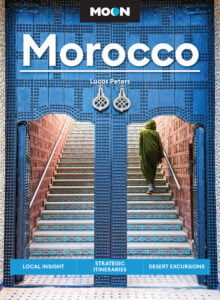
In the 13th century, Morocco’s own Ibn Battuta, in explorer and intrepid traveler, was the first known traveler to connect distant the northwest corner of Africa to the far East. It’s taken nearly eight centuries, but the connection these days between Beijing and Rabat is strong. With stronger political ties, many are following the route of Morocco’s most famed exploring, making the journey from China to Morocco. And make no mistake about it, in just a few short years, this recent influx of Chinese travelers to Morocco has altered the landscape of some of the most popular destinations around the country, largely because of the number of travelers from China choosing big bus tourism over smaller, more independent and sustainable travel.
With Morocco’s arrival on the international travel scene, this growth in big bus tourism is perhaps something to be expected. Still, it can come as a shock to some.
Background of Big Bus Tourism in Morocco
Bus tours of Morocco have been around for decades. Some of these tours begin in Europe, crossing by ferry through Tangier and circling the country. Still others begin out of Marrakesh, Casablanca, Fez and others cities. Though big bus tourism has been around, it hasn’t been until recently that it’s really taken hold. Much of this has to do with the recent agreement between China and Morocco to eliminate travel visas between the two countries and how many Chinese travelers choose to travel by bus.
Before 2016, any traveler holding a Chinese passport needed to pass special visa requirements to visit Morocco. With China’s interest in Africa since the beginning of this century, naturally, there has been an increased interest in Africa’s strategic northwest corner that overseas shipping through the Mediterranean and into the Atlantic. This interest culminated in a historic visit of King Mohamed VI of Morocco to Bejing to finalize a litany of discussions with President Xi Jinping. Of the fourteen resolutions agreed upon, one did away with the need for visa requirements for Chinese tourists to Morocco.
The result? In 2015, Moroccan had an estimated 10,000 Chinese tourists. By 2018, this number had risen to 132,000, an increase of over 1,000%. By 2020, this number is thought to be increase to as many as 500,000.
By far, the most popular form of travel for the majority of these travelers are big bus tours. In bus numbers, this means that an estimated 200 buses were needed over the course of the year in 2015 to support the number of travelers coming from China. That’s about four buses a week spread throughout a country the size of California. In short, all though big bus tourism existed, it still wasn’t all too common to see these sorts of bus tours in 2015.
By 2018, we were seeing 50 buses a week, many of them doubling or tripling up, dumping off their passangers in the main squares of Fez, the small medina of Chefchaouen, and the larger hotels that have sprouted up around Erfoud and Merzouga to support this type of tourism. Big buses are more-and-more of a common sight around the country.
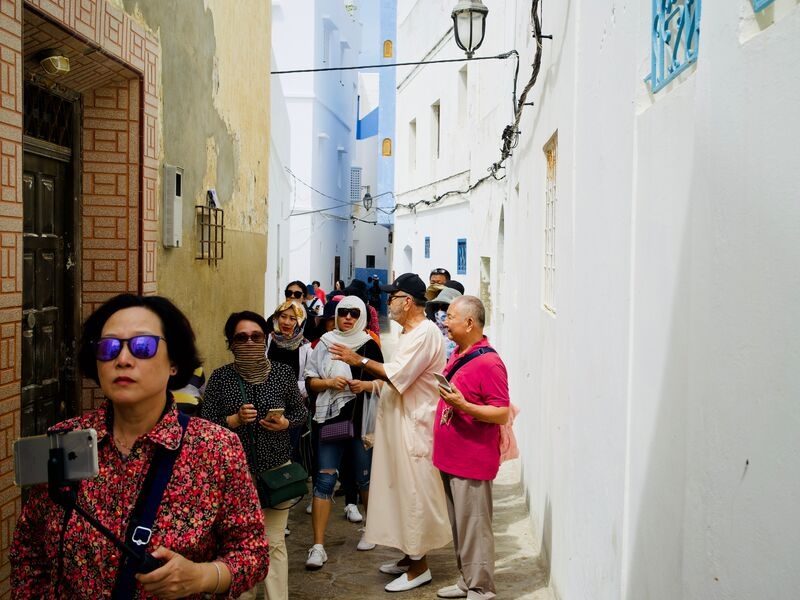
Big Bus Tourism in Morocco Today
Bus tours have been a part of the Moroccan travel experience for decades. If you’re reading this article, likely you already know where we, as a company, stand in relation to big-bus tourism. In short, we don’t support it. It is disconcerting to see loads of tourists shuttled on and off a sixty-seat charter bus, following a frowning man in a bright orange jacket waving a flag, shouting instructions as loud as he can. Most travelers on these sorts of tours end up not knowing much of what they are seeing or why, cameras in hand, looking around in wide-eyed amazement. Their tour guides shuffle them from place to place without ever really explaining what they’re seeing or why. They click photo after photo without having an in-depth understanding of what they’re photographing — or if the people even mind having a camera pointed in their direction! Popular destinations such as Paris and Rome have even gone to extraordinary measures to ban bus tours. Why? Because large bus tours have long-term negative impacts on sustainable tourism and the environment.
All of this isn’t particularly new to Morocco. We’ve written quite a bit about photography in Morocco and how to travel respectfully and sustainably to combat big-bus tourism. However, what we’re seeing on the ground over the past couple of years has been a sharp uptick in the overall number of these types of bus tours, most of them filled with people from Bejing and Hangzhou. It is really unfortunate that the majority of Chinese tourism in Morocco has thus far been of the “big bus” variety. We’re hoping this changes in the near future as people around the world look to forms of more sustainable travel.
Today, there are more buses on the roads, in the squares, parked in front of the Hassan II Mosque, pulling up to the Jemma el-Fna, and manuevering the tricky passes over the High Atlas. The typical route takes travelers on a rushed tour where over the course of fifteen days they visit the major cities (Casablanca, Fez, Tangier and Marrakesh) and also make stops in several smaller locations, such as Chefchaouen, Ifrane, Merzouga and Essaouira.
In just a few short years since the spurt in big bus tourism, the biggest surprises have been the businesses, particularly restaurants, catering to travelers that have popped up all over the country. Though landscape-altering, for those of us living in Morocco who are foodies, the availability of good Chinese food, in particular, has been a welcomed treat!
A quick restaurant note: In Marrakesh, one of the hottest restaurants is Ling Ling, a Cantonese-food paradise with some mouthwatering dim-sum. Chefchaouen, keeping with its budget-friendly backpacker routes, has sprouted a number of Chinese noodle joints.
Fez and Marrakesh there are guides who now give tours in Mandarin, while Ouarzazate has seen a recent surge in interest from movie-loving travelers from the Far East. Occasionally, you can even spot Mandarin-language signage along the roads and cities of Morocco!
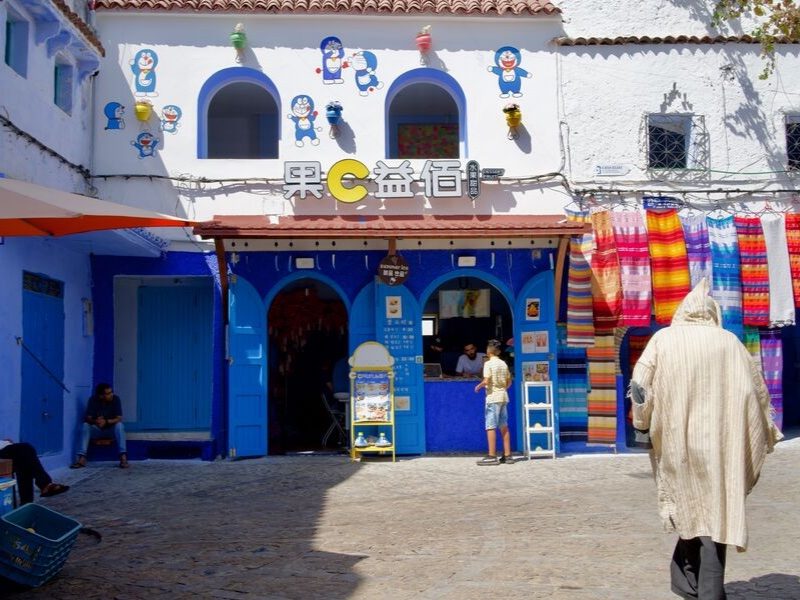
Solutions for Avoiding the Crowds
Morocco has long been a popular destination for Europeans and, since the turn of the century, it has been on the mind of most intrepid North American travelers. However, it would be naive to say anything other than the growth of big bus tourism, more specifically from China, has impacted travel here like nothing we have ever before seen. In the end, for many of us, it’s not a question of how other people travel… it’s a question of how to avoid the crowds.
Here are some tips for avoiding the crowds:
- Travel off-season. Spring time and the winter holiday season are, by far, Morocco’s busiest times of year. Consider booking a trip for February or June instead. These are great shoulder seasons. You can see a lot of the country, including some of the most popular destinations, and the crowds are guarantted to be at their lowest.
- Get off the circuit. Though we do a better job than most of navigating the circuit that connects Casablanca with Fez, the Sahara, and Marrakesh, it would be disingenious to say that this is not the most popular route for first time travelers to Morocco, and for good reason. On this circuit, you can see the most well-known attractions and experiences that Morocco has to offer. That said, if avoiding crowds is your thing, consider visiting parts of the country that are still amazing, but less discovered. Some ideas include: Erg Chigaga, Morocco’s “other” great Saharan dune, Tiznit, Tafraoute, and the rest of the relatively unexplored Souss region. Additionally, outside of the summer months, you could consider exploring Tangier, Tetouan and Asilah, perhaps in addition to a week in Andalusia, just a quick ferry ride away, and really delve deep into exploring the north of Morocco.
- Travel with a small, reputable tour operator. Forgive the shameless plug here, but one of the easiest ways to ditch the crowds is to travel with an outfit like Journey Beyond Travel. Our guides are adept avoiding some of the most crowded spots and giving private experiences intended just for you. Don’t just take our word for it. Check out this fantastic read from Drink Tea Travel about the advantages of traveling with a small small tour operator committed to sustainability.
- Suck it up. For popular destinations, such as Marrakesh, there just is no such thing as “avoiding the crowds.” The diverse, international crowd has long been part of the experience. Revel in it! Enjoy the fact that there is such a diverse set of restaurants appealing to all taste bud types. For some sights, such as the Majorelle Gardens or Saadian Tombs, you’ll want get there right at opening and budget a little extra time, just in case.
In the next 5-10 years, the Ministry of Moroccan Tourism hopes to have nearly 1 million tourists visit annually and travel by bus. That’s another 20,000 full buses a year, or nearly 400 a week.. Beyond continuing to do what we do — give bespoke, customized tours to small groups, families and friends; give generously to NGOs around the country; support sustainable tourism initiatives and small businesses — there best thing we can do is prepare for the inevitable change in this landscape. Lucky for us, Morocco has been changing for centuries, the meeting of cultures, of peoples, of ideas. It is a resilient place, somehow always touched by tourism, always accommodating, though never truly altered. Something tells me Ibn Battuta would be happy to see so many people coming from halfway around the world to travel around his home, meet his people, and celebrate a new friendship over a pot of sweet mint tea.
About the Author
 Written by Morocco expert, award-winning author and photographer Lucas Peters. Lucas has spent over a decade traveling Morocco. He is the writer and photographer of the popular guidebook Moon Morocco and the editor of our award-winning blog. He lives in Tangier with his wife and son.
Written by Morocco expert, award-winning author and photographer Lucas Peters. Lucas has spent over a decade traveling Morocco. He is the writer and photographer of the popular guidebook Moon Morocco and the editor of our award-winning blog. He lives in Tangier with his wife and son.

